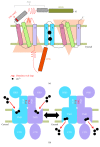Function, Structure, and Transport Aspects of ZIP and ZnT Zinc Transporters in Immune Cells
- PMID: 30370308
- PMCID: PMC6189677
- DOI: 10.1155/2018/9365747
Function, Structure, and Transport Aspects of ZIP and ZnT Zinc Transporters in Immune Cells
Abstract
Zinc is an important trace metal in immune systems, and zinc transporters are involved in many immune responses. Recent advances have revealed the structural and biochemical bases for zinc transport across the cell membrane, with clinical implications for the regulation of zinc homeostasis in immune cells like dendritic cells, T cells, B cells, and mast cells. In this review, we discuss the function, structure, and transport aspects of two major mammalian zinc transporter types, importers and exporters. First, Zrt-/Irt-like proteins (ZIPs) mediate the zinc influx from the extracellular or luminal side into the cytoplasm. There are 14 ZIP family members in humans. They form a homo- or heterodimer with 8 transmembrane domains and extra-/intracellular domains of various lengths. Several ZIP members show specific extracellular domains composed of two subdomains, a helix-rich domain and proline-alanine-leucine (PAL) motif-containing domain. Second, ZnT (zinc transporter) was initially identified in early studies of zinc biology; it mediates zinc efflux as a counterpart of ZIPs in zinc homeostasis. Ten family members have been identified. They show a unique architecture characterized by a Y-shaped conformation and a large cytoplasmic domain. A precise, comprehensive understanding of the structures and transport mechanisms of ZIP and ZnT in combination with mice experiments would provide promising drug targets as well as a basis for identifying other transporters with therapeutic potential.
Figures


Similar articles
-
Zinc Homeostasis in Bone: Zinc Transporters and Bone Diseases.Int J Mol Sci. 2020 Feb 12;21(4):1236. doi: 10.3390/ijms21041236. Int J Mol Sci. 2020. PMID: 32059605 Free PMC article. Review.
-
The Physiological, Biochemical, and Molecular Roles of Zinc Transporters in Zinc Homeostasis and Metabolism.Physiol Rev. 2015 Jul;95(3):749-84. doi: 10.1152/physrev.00035.2014. Physiol Rev. 2015. PMID: 26084690 Review.
-
The Functions of Metallothionein and ZIP and ZnT Transporters: An Overview and Perspective.Int J Mol Sci. 2016 Mar 4;17(3):336. doi: 10.3390/ijms17030336. Int J Mol Sci. 2016. PMID: 26959009 Free PMC article. Review.
-
[Overview of and update on the physiological functions of mammalian zinc transporters].Nihon Eiseigaku Zasshi. 2013;68(2):92-102. doi: 10.1265/jjh.68.92. Nihon Eiseigaku Zasshi. 2013. PMID: 23718971 Review. Japanese.
-
ZIP transporters-regulated Zn2+ homeostasis: A novel determinant of human diseases.J Cell Physiol. 2024 May;239(5):e31223. doi: 10.1002/jcp.31223. Epub 2024 Mar 26. J Cell Physiol. 2024. PMID: 38530191 Review.
Cited by
-
Quantum molecular resonance ameliorates atopic dermatitis through suppression of IL36G and SPRR2B.BMB Rep. 2025 May;58(5):209-216. doi: 10.5483/BMBRep.2024-0105. BMB Rep. 2025. PMID: 39757204 Free PMC article.
-
Exploring the Use of Intracellular Chelation and Non-Iron Metals to Program Ferroptosis for Anticancer Application.Inorganics (Basel). 2024 Jan;12(1):26. doi: 10.3390/inorganics12010026. Epub 2024 Jan 8. Inorganics (Basel). 2024. PMID: 39380574 Free PMC article.
-
Zinc and its role in vitamin D function.Curr Res Physiol. 2022 Apr 30;5:203-207. doi: 10.1016/j.crphys.2022.04.001. eCollection 2022. Curr Res Physiol. 2022. PMID: 35570853 Free PMC article. Review.
-
Solute carrier transporters: the metabolic gatekeepers of immune cells.Acta Pharm Sin B. 2020 Jan;10(1):61-78. doi: 10.1016/j.apsb.2019.12.006. Epub 2019 Dec 14. Acta Pharm Sin B. 2020. PMID: 31993307 Free PMC article. Review.
-
Capsaicin and Zinc Signalling Pathways as Promising Targets for Managing Insulin Resistance and Type 2 Diabetes.Molecules. 2023 Mar 22;28(6):2861. doi: 10.3390/molecules28062861. Molecules. 2023. PMID: 36985831 Free PMC article. Review.
References
Publication types
MeSH terms
Substances
LinkOut - more resources
Full Text Sources
Medical

